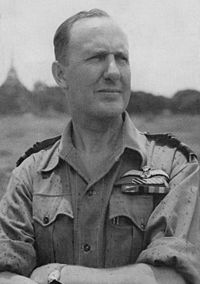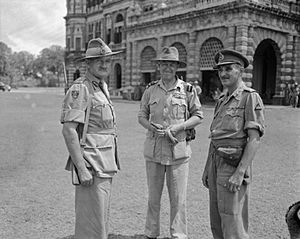Stanley Vincent facts for kids
Quick facts for kids
Air Vice Marshal Stanley Vincent
|
|
|---|---|

Air Vice Marshal Vincent in 1945
|
|
| Born | 7 April 1897 Hampstead, London |
| Died | 13 March 1976 (aged 78) Bury St Edmunds, Suffolk |
| Allegiance | United Kingdom |
| Service/ |
British Army (1915–18) Royal Air Force (1918–50) |
| Years of service | 1915–1950 |
| Rank | Air Vice Marshal |
| Commands held | No. 11 (Fighter) Group (1948–50) No. 221 Group (1944–45) No. 13 (Fighter) Group (1943–44) No. 226 (Fighter) Group (1942) RAF North Weald (1941) RAF Northolt (1937, 1940–41) No. 84 Squadron (1933–35) No. 41 Squadron (1931–33) |
| Battles/wars | First World War Second World War |
| Awards | Companion of the Order of the Bath Distinguished Flying Cross Air Force Cross Mentioned in Despatches Commander of the Legion of Merit (United States) |
| Other work | Eastern Area Commandant Royal Observer Corps (1954–65) |
Air Vice Marshal Stanley Flamank Vincent (7 April 1897 – 13 March 1976) was a brave pilot and a high-ranking officer. He served in the Royal Flying Corps (RFC) and later the Royal Air Force (RAF). He holds a unique record: he was the only RFC/RAF pilot to shoot down enemy aircraft in both World War I and World War II.
Contents
Early Life and Education
Stanley Vincent was born on April 7, 1897, in Hampstead, a part of north London. His parents were Dr. Charles Vincent and Hannah Phillips. He went to school at Lancing College.
Becoming a Pilot
Stanley Vincent joined the Royal Flying Corps (RFC) in 1915 after finishing his training. His first assignment was with No. 60 Squadron RAF in France in April 1916. He flew early fighter planes like the Morane Bullet and the Nieuport 17.
In July 1916, he achieved his squadron's first victory by shooting down an enemy plane. He shot down more enemy aircraft in the following months. In March 1917, he helped set up a special flying school at Gosport. Later that year, he was injured in a crash and spent seven months recovering in the hospital.
In November 1917, Vincent was given command of the new No. 110 Squadron RAF. He later helped train other instructors. In 1918, he received the Air Force Cross for his bravery. After World War I, he helped bring back captured German planes and trained pilots who had been prisoners of war. He even helped train the Prince of Wales, who later became King Edward VIII.
Between the World Wars
In 1921, Stanley Vincent became a flight commander at the new Royal Air Force College Cranwell. This was a special college for training future RAF leaders.
He then went to Iraq in 1923 to fly with No. 30 Squadron RAF. After his time overseas, he returned home in 1928 to join No. 1 Squadron RAF. In 1931, he became a squadron leader and took command of No. 41 Squadron RAF at RAF Northolt. Here, he worked on early experiments with radio communication in aircraft.
He returned to Iraq for a short time to lead No. 80 Squadron RAF. During this period, he took part in the first flight to reinforce Singapore. He became ill in late 1934 and returned home. In 1936, he was put in charge of the Air Fighting Development Unit. Later that year, he was promoted to wing commander and became the commanding officer of RAF Northolt.
World War II Heroics
In March 1940, Stanley Vincent returned to RAF Northolt as its commander. He led the station during the famous Battle of Britain. This was a critical air battle where the RAF defended Britain from German attacks.
Vincent often flew with his squadrons, like 229 and 257 Squadrons. He also flew solo missions to defend the air base. He believed he shot down five German Dornier Do 17 bombers during these flights. Since he was often alone, these victories were never officially confirmed. However, he did claim two more victories over German Bf 109 fighters on September 30, 1940. During one battle, he was wounded and had to crash-land his plane. He was awarded the Distinguished Flying Cross in 1940 for his amazing skill and bravery.
In 1941, he moved to RAF North Weald and then to RAF Fighter Command HQ. He was promoted to Air Commodore in early 1942.

Vincent asked for active duty and was sent to help defend Singapore and the Dutch East Indies. In February 1942, he took command of No. 226 Group RAF, a group of Commonwealth fighter planes. They had only two Hurricane squadrons and some older Brewster Buffalo planes. They were greatly outnumbered by the enemy. In March, Vincent was evacuated to Australia, where he advised on air defense. He then served as Deputy Chief of the Air Staff for the Royal New Zealand Air Force for nine months.
He returned to England in mid-1943 and later commanded No. 13 Group RAF in Scotland. He was also chosen to lead the planned invasion of Norway, but this plan did not happen. He then went back to Asia to command No. 221 Group RAF in Burma. Here, he provided air support for the 14th Army. He stayed in Asia until the end of the war. On the day of the victory parade, he was sent home due to illness.
After the War
Stanley Vincent was promoted to acting air vice marshal in 1944, a rank that became permanent in 1947. From 1945 to 1948, he was a Senior Air Staff Officer at RAF Fighter Command. From 1948, he commanded No. 11 Group RAF. He asked to retire in 1950.
After retiring from the RAF, he served as Commandant for the Eastern Area of the Royal Observer Corps from 1954 to 1965. He wrote his life story, called Flying Fever, in 1972. He passed away in 1976.
On September 15, 2010, a replica Hawker Hurricane plane was put on display at RAF Northolt. It was painted in the colors of the Hurricane plane that Stanley Vincent flew.
Images for kids
See Also
- Harry von Bülow-Bothkamp
- Otto Höhne
- Erich Mix
- Theo Osterkamp
- Marcel Haegelen


